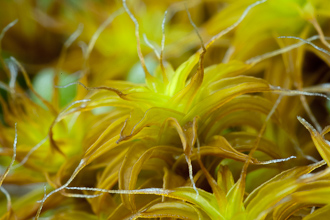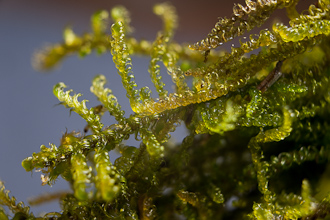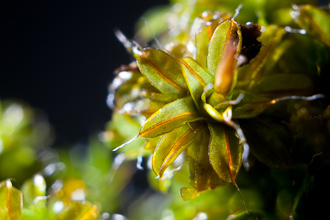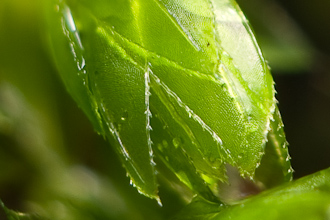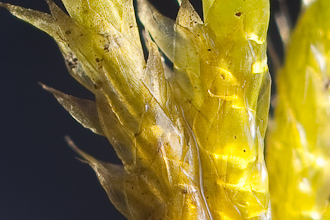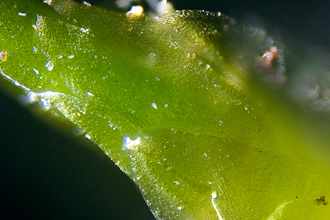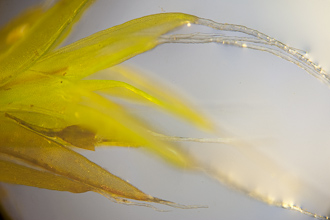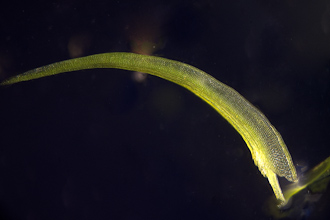
-
Plant growth habit
-
Shoot growth form / colour
-
Arrangement of the leaves
-
Details of the leaves
- Hairpoint:
-
Leaves recurved, hooked, squarrose
Note:
Apices bent abruptly to the side or downwards - Costa:
- Teeth:
- Leaf margins:
- Leaf surface:
-
Reproductive structures
- Distinctive gemmae present:
- Colour of seta:
- Form of the capsule:
Note:
Distinctive capsules only.
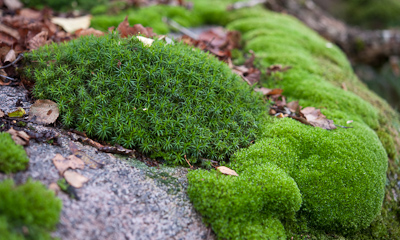
The wonderfully-named glen "My Lord's Throat", east of Alford, Aberdeenshire, has a surprisingly western bryophyte flora for a location on the east of Scotland.
Granite boulders are strewn over the steep slopes in this birch woodland, providing a niche for species favouring acid rocks. The photo shows a rich-green mound of Polytrichum accompanied by paler cushions of Bryum.
Bryophyte "organs and tissues" may resemble those of vascular plants, but they must have evolved separately and are not homologous morphological structures. To see why this is so, you have to remember that the leafy moss plant, the gametophyte, comprises haploid cells. Cells of this ploidy in flowering plants are found in the pollen grains and the ovules, while the leafy shoots are part of the diploid sporophyte plant body. The sporophyte on mosses comprises the semi-parasitic seta and moss capsule.
And so although we use terms such as shoot and leaf to describe parts of mosses that play similar roles to the same-named parts in vascular plants, they arise in a different generation in the life cycle. If a pollen grain or ovule developed photosynthetic shoots and leaves, we'd have something more akin to the moss gametophyte.
The overall similarity in plant structure between moss gametophytes and vascular plant sporophytes must be the result of convergent evolution.
To reflect these different origins, technical terms for the shoot-like and leaf-like parts of mosses have been defined, although these are rarely used by bryologists. However, this distinct nature of moss parts is worth bearing in mind and may go some way to explaining the ways in which moss "shoots" and "leaves" can demonstrate innovations in form and structure that are not found in vascular plants.
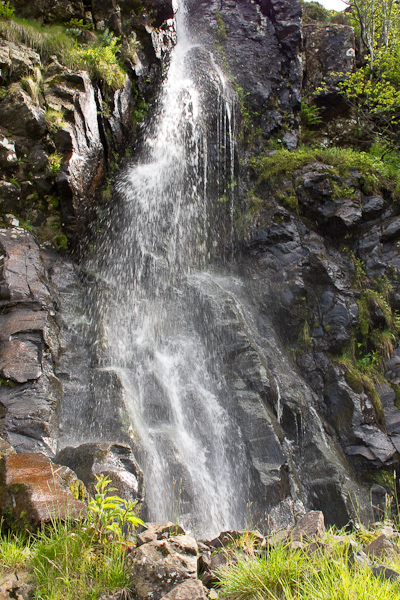
Cloch Burn drops over the cliffs at the Corrie of Balglass near Fintry, Stirlingshire, creating a variety of niches inhabited by a range of mosses and liverworts.
- Mosses and Liverworts of Britain and Ireland, BBS (2010)
- The Moss Flora of Britain and Ireland, A.J.E. Smith (2008)
- Mosses and Liverworts, R. Porley & N. Hodgetts (2005)
- British Mosses and Liverworts, E. V. Watson (1995)
- The Structure and Life of Bryophytes, E. V. Watson (1971)
- An Introduction to Bryophyta, A. Rashid (2004)
- Some Common Mosses of British Columbia (1992)
- Common Mosses of the NE and Appalachians (2013)
- Leaf margins:
- Recurved
- Not recurved
- Leaf surface:
- Wavy / undulate
- Flat / Smoothly curved
- Distinctly folded or with a keel
- Outline shape of the leaves
- Colour of the leaves:
- Yellow-green
- Yellow
- Orange
- Red
- Red-brown
- Black
- Silvery
- Shape of the leaf cells in different parts of the leaf
- Bryum capillare
- Bartramia pomiformis
- Brachythecium albicans
- Grimmia laevigata
- Hedwigia stellata
- Orthotrichum diaphanum
-
Pogonatum aloides
Note:
The marginal border cells in Pogonatum aloides continue into a robust "spine" at the tip of the leaves. -
Polytrichum commune
Note:
Polytrichum commune has toothed or jagged points at the ends of the leaves. -
Polytrichum piliferum
Note:
Polytrichum piliferum has toothed or jagged points at the ends of the leaves. - Racomitrium heterostichum
- Racomitrium lanuginosum
- Syntrichia laevipila
- Syntrichia ruralis
-
Tetraplodon mnioides
Note:
The long drawn-out wavy leaf point in Tetraplodon mnioides may have small teeth. - Tortula muralis
As hairpoints are generally unpigmented, they perhaps help reduce water loss by the leaves through reducing air flow over the leaf surfaces, while not interfering with light penetration to the photosynthetic cells of the moss.
- Atrichum undulatum
- Amblystegium serpens
- Andreaea
- Aulacomnium androgynum
- Aulacomnium palustre
- Barbula sardoa
- Barbula unguiculata
- Brachythecium populeum
- Brachythecium rutabulum
- Bryum alpinum
- Bryum argenteum
- Bryum pallens
- Bryum pseudotriquetrum
- Calliergonella cuspidata
- Ceratodon purpureus
- Cratoneuron filicinum
- Ctenidium molluscum
- Dicranoweisia cirrata
- Eurhynchium striatum
- Calliergon giganteum
- Climacium dendroides
- Fissidens bryoides
- Funaria hygrometrica
- Gymnostomum aeruginosum
- Gyroweisia tenuis
- Homalothecium sericeum
- Hylocomium splendens
- Hypnum cupressiforme
- Hypnum jutlandicum
- Kindbergia praelonga
- Leucodon sciuroides
- Mnium hornum
- Orthotrichum cupulatum
- Orthotrichum rivulare
- Orthotrichum stramineum
- Palustriella commutata
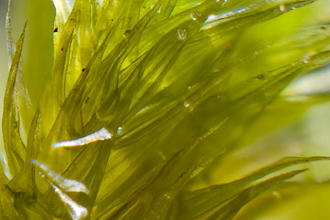 Homalothecium sericeum (Brachytheciaceae)
Homalothecium sericeum (Brachytheciaceae)- Philonotis fontana
- Plagiomnium ellipticum*
- Plagiothecium undulatum
- Pleurozium schreberi
- Pohlia melanodon
- Pohlia wahlenbergia
- Pseudocrossidium revolutum
- Pseudoscleropodium purum
- Pterygonium gracile
- Racomitrium fasciculare
- Rhynchostegium confertum
- Rhytidiadelphus loreus
- Rhytidiadelphus triquetris
- Rhizomnium punctatum
- Schistidium rivulare
- Thamnobryum alopecurum
- Tortella tortuosa
- Trichostomum brachydontium
- Ulota bruchii
- Ulota phyllantha
- Warnstorfia fluitans
I've not yet attempted to see if there's any correlation between presence / absence of hairpoints and the nature of the niches inhabited by each group of mosses.
- Ctenidium molluscum
- Palustriella commutata
- Rhytidiadelphus squarrosus
It seems reasonable to assume that any degree of folding of moss leaves will tend to help retain moist air, but at the expense of not presenting as much of the leaf surface perpendicular to the rays of the sun, compared to what properly-oriented flat leaves can achieve.
- Bryum capillare
- Fissidens bryoides
- Funaria hygrometrica
- Plagiomnium ellipticum*
- Syntrichia laevipila
- Syntrichia ruralis
- Tortula muralis
The costa is associated with structural rigidity and perhaps some degree of water transport, but after it transitions into a hairpoint, it's role may be primarily to reduce water loss.
- Atrichum undulatum
- Aulacomnium androgynum
- Aulacomnium palustre
- Barbula sardoa
- Barbula unguiculata
- Brachythecium rutabulum
- Bryum alpinum
- Bryum pallens
- Bryum pseudotriquetrum
- Ceratodon purpureus
- Climacium dendroides
- Dichodontium palustre
- Dicranoweisia cirrata
- Fissidens dubius
- Philonotis fontana
- Pogonatum aloides
- Polytrichum commune
- Polytrichum piliferum
- Orthotrichum rivulare
- Orthotrichum stramineum
- Palustriella commutata
- Plagiomnium ellipticum*
- Pseudocrossidium revolutum
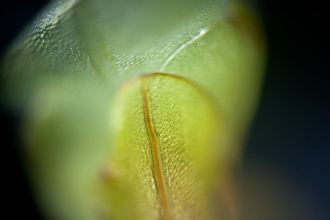 Rhizomnium punctatum (Mniaceae)
Rhizomnium punctatum (Mniaceae)- Racomitrium fasciculare
- Rhizomnium punctatum
- Schistidium rivulare
- Tetraplodon mnioides
- Trichostomum brachydontium
- Ulota bruchii
- Ulota phyllantha
This could, perhaps, be considered the optimal arrangement of the costa from an "engineering" point of view, maximising both the strength and water transport functions of the structure.
- Aulacomnium androgynum
- Brachythecium populeum
- Gyroweisia tenuis
- Kindbergia praelonga
- Mnium hornum
- Pohlia melanodon
- Pohlia wahlenbergia
- Thuidium tamariscinum
Presumably there's little difference in functionality between costas that reach, and those that almost reach, the leaf tip.
- Brachythecium albicans
- Bryum argenteum
- Eurhynchium striatum
- Pseudoscleropodium purum
- Rhynchostegium confertum
- Pterygonium gracile*
- Hylocomium splendens*
- Hypnum cupressiforme*
- Hypnum jutlandicum
- Plagiothecium undulatum
- Pleurozium schreberi*
- Pterygonium gracile*
- Rhytidiadelphus loreus
- Rhytidiadelphus triquetris
- Calliergonella cuspidata
- Ctenidium molluscum
- Hedwigia stellata
- Leucodon sciuroides
- Hylocomium splendens*
- Hypnum cupressiforme*
- Pleurozium schreberi*
It would be an interesting exercise to see if there's any correlation between moss species lacking a costa, and the environment they occupy. Avalability of moisture comes to mind, but C. cuspidata is found in wet environments while H. stellata is often found on exposed rock surfaces in elevated locations.
- Atrichum undulatum
-
Aulacomnium palustre
Note:
Teeth only present towards the tip of the leaves. -
Bartramia pomiformis
Note:
Teeth only present towards the tip of the leaves. -
Brachythecium plumosum
Note:
Denticulate. -
Brachythecium rutabulum
Note:
Denticulate. - Breutelia chrysocoma
-
Bryum rubens
Note:
Commonly faintly toothed towards leaf tip. -
Climacium dendroides
Note:
Branch leaves coarsely toothed towards leaf tip; stem leaves smooth. - Cratoneuron filicinum
- Ctenidium molluscum
-
Dicranella rufescens
Note:
Denticulate at least above. -
Dicranum fuscescens
Note:
Toothed towards leaf tip. -
Dicranum majus
Note:
Sharply toothed towards leaf tip. -
Dicranum scoparium
Note:
Variously toothed towards leaf tip. - Eurhynchium striatum
-
Fissidens adianthoides
Note:
Toothed towards leaf tip. -
Fissidens dubius
Note:
Irregularly toothed towards leaf tip. - Hylocomium splendens
- Hyocomium armoricum
-
Isothecium alopecuroides
Note:
Teeth only present towards the tip of the leaves. - Kindbergia praelonga
- Mnium hornum
-
Oligotrichum hercynicum
Note:
Widely spaced. -
Palustriella commutata
Note:
Denticulate below (and possibly throughout). - Philonotis fontana
-
Plagiomnium ellipticum
Note:
Sometimes lacking. - Plagiomnium rostratum
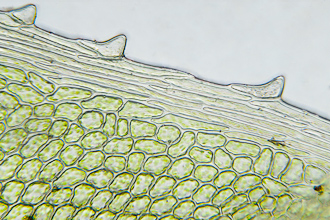 Plagiomnium rostratum (Mniaceae)
Plagiomnium rostratum (Mniaceae)- Plagiomnium undulatum
- Pogonatum aloides
- Pogonatum urnigerum
-
Pseudoscleropodium purum
Note:
"Lightly toothed" according to Watson, although I've not yet noted the teeth. -
Pterygonium gracile
Note:
Dentate above. - Ptychomitrium polyphyllum
- Rhynchostegium confertum
-
Rhodobryum roseum
Note:
Distantly toothed at apex. - Rhytidiadelphus loreus
- Rhytidiadelphus squarrosus
- Rhytidiadelphus triquetris
-
Thamnobryum alopecurum
Note:
At apex.
- Polytrichum piliferum
- Campylopus atrovirens
-
Grimmia pulvinata
Note:
Lightly but distinctly toothed. -
Hedwigia stellata
Note:
Hyaline apex bears spinose teeth. - Racomitrium lanuginosum
- Syntrichia ruralis ssp. ruraliformis
- Amblystegium serpens
- Amphidium mougeotii
- Aulacomnium androgynum
- Barbula convoluta
- Barbula unguiculata
- Brachythecium albicans
- Bryum alpinum
- Bryum argenteum
- Bryum capillare
- Bryum pallens
- Bryum pseudotriquetrum
- Calliergon giganteum
- Calliergonella cuspidata
- Campylopus introflexus
- Ceratodon purpureus
- Dichodontium palustre
- Dicranoweisia cirrata
- Didymodon rigidulus
- Fissidens bryoides
- Funaria hygrometrica
- Grimmia laevigata
- Gymnostomum aeruginosum
- Gyroweisia tenuis
- Homalothecium sericeum
- Hypnum andoi
- Hypnum jutlandicum
- Neckera complanata
- Neckera crispa
- Orthotrichum anomalum
- Plagiothecium undulatum
- Pleurozium schreberi
- Pohlia melanodon
- Pohlia nutans
- Pseudocrossidium hornschuchianum
- Pseudocrossidium revolutum
- Racomitrium aciculare
- Racomitrium fasciculare
- Racomitrium heterostichum
- Rhizomnium punctatum
- Schistidium maritimum
- Schistidium rivulare
- Syntrichia laevipila
- Tortella tortuosa
- Tortula muralis
- Trichostomum brachydontium
- Ulota bruchii
- Ulota phyllantha
- Warnstorfia fluitans
